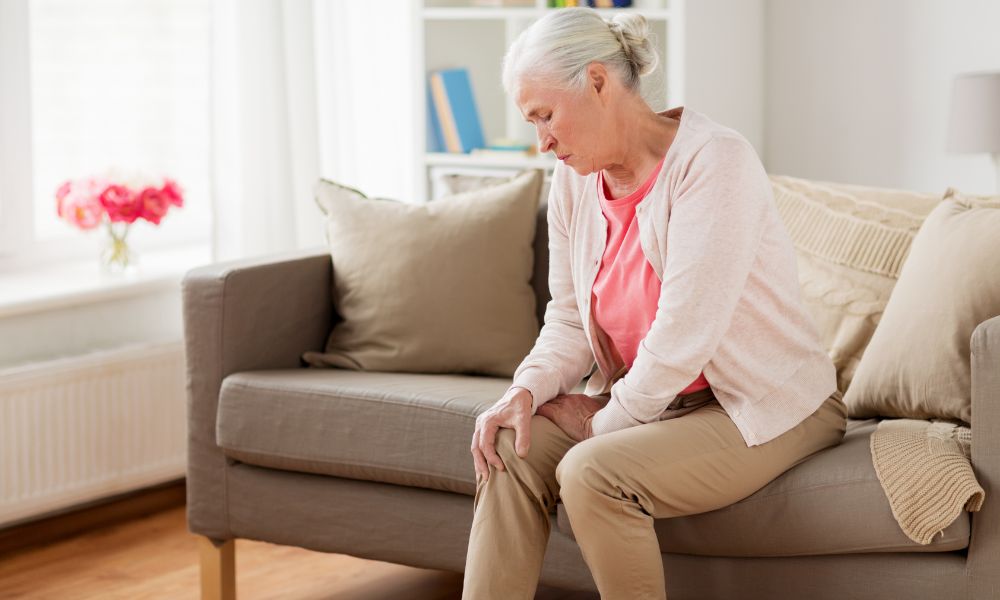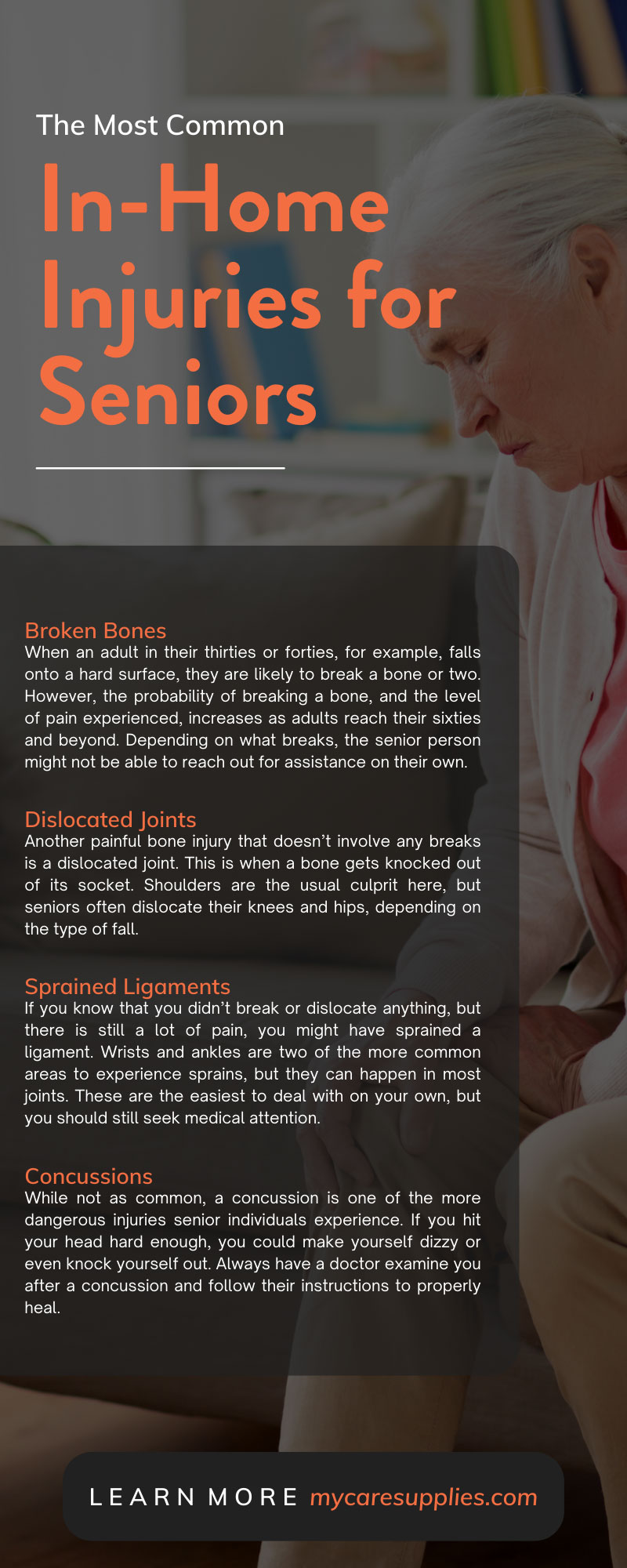The Most Common In-Home Injuries for Seniors
Posted by Jeanne Lowry on Nov 14th 2022

The aging process isn’t something any of us want to go through, but it happens to everyone. No matter how well you take care of yourself, the day will come when parts of your body won’t work as well as they used to. Whether you have a parent who has reached that point or you’re coming close to that age yourself, it’s never a bad idea to know what the most common in-home injuries are for seniors. That way, you can know what to expect and better prepare for them in case they happen unexpectedly.
Most Common Injuries
While the injuries listed here can occur for a variety of reasons, many of them happen after a bad fall. A senior person’s body is more frail, so whether they slip in the bathroom or fall down some stairs, these types of accidents will more likely result in a serious injury. Some common injuries are as follows:
Broken Bones
When an adult in their thirties or forties, for example, falls onto a hard surface, they are likely to break a bone or two. However, the probability of breaking a bone, and the level of pain experienced, increases as adults reach their sixties and beyond. Depending on what breaks, the senior person might not be able to reach out for assistance on their own.
Broken arms make getting up difficult, while a broken leg might keep a person from being able to walk to their car or to a phone. If the person cracks a rib, the pain might be too intense for them to even move.
Dislocated Joints
Another painful bone injury that doesn’t involve any breaks is a dislocated joint. This is when a bone gets knocked out of its socket. Shoulders are the usual culprit here, but seniors often dislocate their knees and hips, depending on the type of fall.
Unlike breaks, with the proper knowledge and technique, a person can fix a dislocation on their own—though, we do not recommend this. Before all else, seek medical attention as soon as possible.
Sprained Ligaments
If you know that you didn’t break or dislocate anything, but there is still a lot of pain, you might have sprained a ligament. Wrists and ankles are two of the more common areas to experience sprains, but they can happen in most joints. These are the easiest to deal with on your own, but you should still seek medical attention. Just make sure you ice it while waiting for assistance.
Concussions
While not as common, a concussion is one of the more dangerous injuries senior individuals experience. If you hit your head hard enough, you could make yourself dizzy or even knock yourself out. Always have a doctor examine you after a concussion and follow their instructions to properly heal.
Lacerations
While major lacerations and minor cuts can happen after a bad fall, these types of injuries are more likely when working in the kitchen. Using knives and other sharp objects require careful control and focus, two things that some seniors might struggle with. Some senior persons may feel like they’re losing their personal freedoms if they’re no longer able to make their own meals.
That said, if you wish to continue to make your meals for as long as you are able, please take extra care when using sharp objects. Try to find alternative utensils and tools that are less dangerous and easy to use; and consider cooking in the company of a loved one or trusted friend, in case of an emergency.
Infections
Even if a cut isn’t too bad, it could lead to another major issue: infection. If an infection goes untreated long enough, it could really impact your overall health. No matter how insignificant a cut may seem, always treat it immediately to avoid this issue.
Burns
If the injury sustained by a senior person didn’t come from a bad fall, there’s a good chance it came from a fire. Burns are quite common in the senior community. They usually don’t come from house fires, though.
Most burns occur when cooking. It’s just one more thing to be extra careful of when in the kitchen. No matter how bad the burn is, always have a doctor treat it. Like cuts, burns are also at risk of infection.
Asphyxiation
The chance of choking on food or a drink also increases as you age. Reactions needed to stop this issue aren’t as fast as they used to be. Too many people, regardless of their age, think a choking incident will never happen to them until it does. That’s why, every time you eat, it’s imperative you take small bites and chew your food thoroughly before swallowing it.
Bedsores
The final common in-home injury that seniors might experience is bedsores. Bedsores can easily develop if you are bedridden due to one of the previously mentioned injuries or an unrelated health condition. They typically occur after blood circulation is cut off from a part of the body for a few hours. While in bed, make sure you move every so often to ensure your blood flows unhindered.
How To Prevent These Problems
Of course, knowing about these problems is only part of the solution. You’ll also want to set up some preventive measures to reduce the risk of them happening in the first place. Here are some suggestions to help ensure your safety at home:
Remove Potential Fall Points
The first thing to do is prevent the possibility of a fall. Stairs are a common culprit, so if you can move to a single-level house, that will be your best bet. If you can’t afford to move houses, consider moving from your upstairs bedroom to a bedroom downstairs. Remember to bring all your important items down to with you.
Tubs are also quite dangerous. If you can’t afford a walk-in bathtub, install handles on both sides of the one you have. This will make it much easier to get in and out without slipping or tripping.
Store a Few First-Aid Kits
Telling your doctor about any injuries you experience is a good practice in general, though you can treat most minor cuts and burns on your own with the proper supplies, such as sterile dressings and bandages. If you put a few first-aid kits throughout the house, you won’t have to worry about them being out of reach when an accident occurs. Just make sure you pack each one with wound care supplies and other emergency items you might need.
Treat Incontinence
Tell your doctor if you are experiencing incontinence. Many falls happen due to urgently rushing to restrooms due to incontinence symptoms. Your physician may recommend exercises or training for your bladder, or prescribe incontinence products such as briefs or pull-ups.
Have a Reliable Way To Call for Help
Even though many senior people have cell phones these days, they’re not always in an accessible location after an accident. That’s why it’s a good idea to have a necklace or watch that you can use to call for help. These items will always be with you, so you won’t have to search for them while injured.
Hire an At-Home Nurse
Ultimately, the safest option is to hire an at-home nurse to help care for you. Not only will they be there to immediately assist you if something goes wrong, but they will be able to help you with some of the more dangerous tasks around the house. Nothing will keep you safer than having a trusted person with you 24/7.


